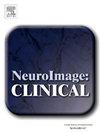痴呆患者冷漠和抑郁症状之间的功能和微结构神经基质
IF 3.4
2区 医学
Q2 NEUROIMAGING
引用次数: 0
摘要
抑郁症状和冷漠的重叠特征阻碍了它们在临床实践中的区分,因此有必要更好地了解它们在痴呆及其亚型中的神经基质。痴呆患者92例(老年痴呆症[AD, n = 52];采用冷漠评定量表(AES)、贝克抑郁量表(BDI)和脑磁共振成像(MRI)对30名认知正常受试者进行评估。根据AES/BDI评分分组,通过比较静息状态功能MRI的低频波动分数幅值(fALFF)和扩散峰度成像的平均峰度(MK)等MRI指标,确定抑郁/冷漠中心。分析了中心与抑郁和冷漠症状之间的关系。与低aes组和高aes组相比,fALFF主要在默认模式网络(DMN)和额顶叶网络(FPN)内发生普遍变化。比较低bdi组和高bdi组,fALFF反映了DMN、FPN和显著性网络(SAN)的变化。相反,MK在同一组比较中显示DMN和SAN区域的焦点变化。fALFF与AES的DMN/FPN的相关性高于BDI,与SIVD的相关性高于AD, MK与AES的左前扣带皮层和右岛的相关性高于BDI,但与AD的相关性高于SIVD(均P <;0.01)。在拓扑结构上,AES和BDI的fALFF中心分别位于后极和前极。这些发现表明,双模态MRI可以反映AD和SIVD中冷漠和抑郁症状的独特神经病理学基础。本文章由计算机程序翻译,如有差异,请以英文原文为准。

Functional and microstructural neurosubstrates between apathy and depressive symptoms in dementia
The overlapping features of depressive symptoms and apathy hinder their differentiation in clinical practice, and hence a greater understanding of their neurosubstrates in dementia and its subtypes is necessary. Ninety-two dementia patients (Alzheimer’s disease [AD, n = 52]; subcortical ischemic vascular disease [SIVD, n = 40]), and 30 cognitively normal subjects were evaluated using the Apathy Evaluation Scale (AES), Beck’s Depression Inventory (BDI), and brain magnetic resonance imaging (MRI). Grouped by AES/BDI scores, and hubs of depression/apathy were identified by comparing MRI metrics including fractional amplitude of low-frequency fluctuation (fALFF) of resting-state functional MRI, and mean kurtosis (MK) of diffusion kurtosis imaging. Associations between the hubs with depressive and apathy symptoms were analyzed. Comparing low-AES and high-AES groups, fALFF indicated pervasive changes mainly within the default mode network (DMN) and frontoparietal network (FPN). Comparing low-BDI and high-BDI groups, fALFF reflected changes within the DMN, FPN, and salience network (SAN). Contrarily, MK showed focal changes within DMN and SAN regions from the same group-wise comparisons. While fALFF was more correlated with DMN/FPN for AES than BDI and more significantly correlated with SIVD than AD, MK was more correlated with the left anterior cingulate cortex and right insula for AES than BDI, but more significantly correlated with AD than SIVD (all P < 0.01). Topologically, the fALFF hubs for AES and BDI centered at the posterior and anterior poles, respectively. These findings suggest that dual-modal MRI could reflect the distinct neuropathological basis for apathy and depressive symptoms in AD and SIVD.
求助全文
通过发布文献求助,成功后即可免费获取论文全文。
去求助
来源期刊

Neuroimage-Clinical
NEUROIMAGING-
CiteScore
7.50
自引率
4.80%
发文量
368
审稿时长
52 days
期刊介绍:
NeuroImage: Clinical, a journal of diseases, disorders and syndromes involving the Nervous System, provides a vehicle for communicating important advances in the study of abnormal structure-function relationships of the human nervous system based on imaging.
The focus of NeuroImage: Clinical is on defining changes to the brain associated with primary neurologic and psychiatric diseases and disorders of the nervous system as well as behavioral syndromes and developmental conditions. The main criterion for judging papers is the extent of scientific advancement in the understanding of the pathophysiologic mechanisms of diseases and disorders, in identification of functional models that link clinical signs and symptoms with brain function and in the creation of image based tools applicable to a broad range of clinical needs including diagnosis, monitoring and tracking of illness, predicting therapeutic response and development of new treatments. Papers dealing with structure and function in animal models will also be considered if they reveal mechanisms that can be readily translated to human conditions.
 求助内容:
求助内容: 应助结果提醒方式:
应助结果提醒方式:


